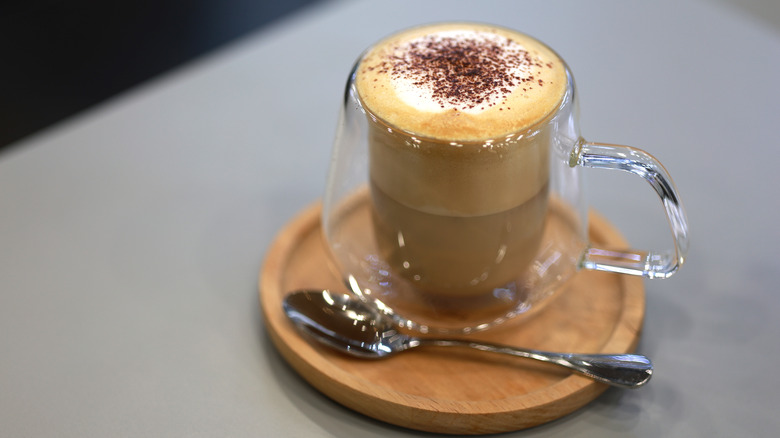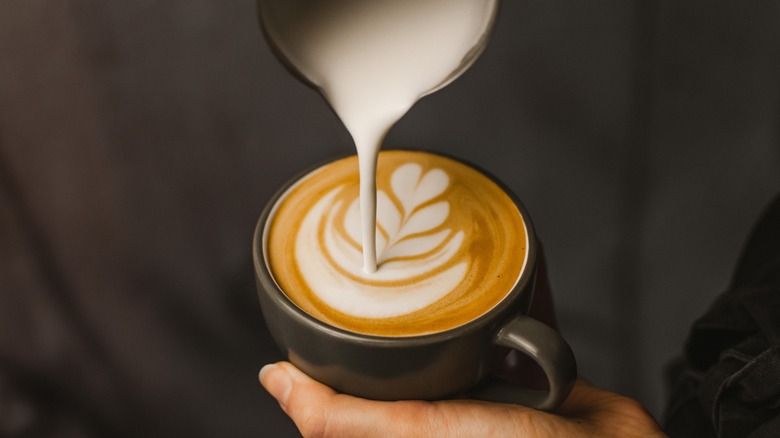Dry Cappuccinos Are Not Exactly What They Sound Like
So you're standing in a long queue of people patiently waiting to place their coffee orders with the barista, but what's that — did you just hear someone ask for a dry cappuccino? What does a dry cappuccino even mean? Is it some dehydrated version of liquid coffee, or a type of instant coffee that can produce hot cappuccinos in a snap, perhaps? Maybe it's new lingo among coffee drinkers that you simply didn't know about? Though its name may justifiably cause much confusion, a dry cappuccino isn't as perplexing as it may seem. In reality, a dry cappuccino is nothing but a regular cappuccino except with less liquid milk and more milk foam.
To understand what a dry cappuccino is, it's paramount to know what makes a good cup of cappuccino first. A cappuccino has three components: espresso, steamed milk, and a layer of foamy textured milk known as microfoam. Cappuccinos usually have equal parts of all three components, but the ratios aren't always set in stone. Those who don't care much for milky espresso can always request that their cappuccinos have more microfoam, and that's all that a dry cappuccino really is! Because steamed milk is considered to be a wet ingredient, and the microfoam is thought to be a dry one, a dry cappuccino just means that it has more of that creamy foam and less of the liquid milk.
The taste and texture of dry cappuccinos
So a dry cappuccino is more foam and less milk, but why would anyone want to throw the delicate balance of a perfectly good cappuccino off-kilter in the first place? Well, there's a good reason for it. For one, reducing steamed milk in the java leaves more room for the flavors of the espresso to shine. Reducing the liquid also subdues the sweet taste of dairy, which is why dry cappuccinos are excellent for those who don't fancy milky cups of Joe. Essentially then, a dry cappuccino highlights the rich flavors of the espresso more than a standard one and generally tastes sharper – stronger.
Flavor aside, switching the ratio of steamed milk and foam also has an obvious effect on the coffee's texture — dry cappuccinos are thicker, denser, smoother, and foamier. The foam even acts as a cushion around the espresso, which helps dry cappuccinos stay warm for a longer period. The only downside of ordering this drink is that foam tends to dissipate pretty fast, and you may find that there is little besides espresso left in your cup after a few minutes. Additionally, while reduced steamed milk has its perks, it's important to bear in mind that the liquid also masks the harsher flavors of espresso. Without the milk, you may very well find these notes are more pronounced in the dry cappuccino, especially if the coffee beans used are particularly dark and bitter.
There's a drier (and wetter) version of a dry cappuccino
While dry cappuccinos are one way to put a spin on the traditional drink, it's not the only way that a cappuccino can be customized. On the very opposite end of a dry cappuccino is a wet one. Where a dry cappuccino has more foam than milk, a wet cappuccino has — you guessed it — less foam and more steamed milk. Although this may sound a lot like a latte — which too is made from espresso, steamed milk, and a layer of milk foam — the two aren't the same. Think of a wet cappuccino as a drink between a regular cappuccino and a latte: It has less microfoam than a regular cappuccino but still more than the thin layer that tops a latte.
There also exists an even drier version of a dry cappuccino. Known as a bone-dry cappuccino, this drink is essentially just espresso with a dense blanket of microfoam and nothing else, not a drop of steamed milk. Bone-dry cappuccinos are similar to macchiatos in that regard, except they have more milk foam than the tiny spoonful that goes into the latter. So, the next time you hear someone ask for a dry, bone-dry, or even a wet cappuccino, don't be befuddled — they're just names for cappuccinos with varying ratios of steamed milk and milk foam.



